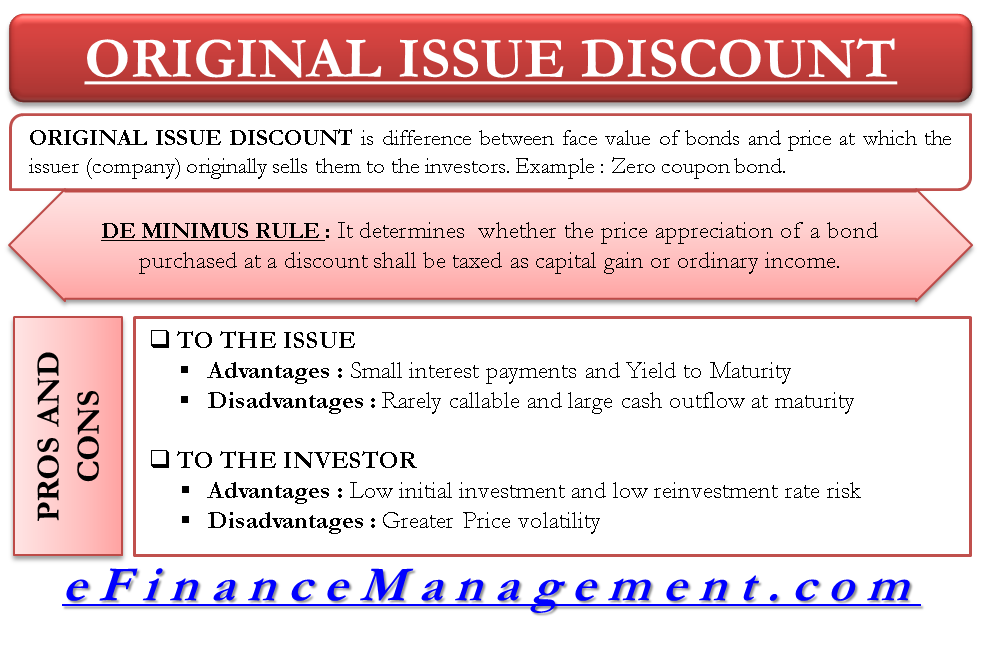What are Original Issue Discount (OID) Bonds?
Original issue discount is the difference between the face value of bonds and the price at which the issuer (company) originally sells them to the investors. On its maturity, the redemption of the bond takes place, and the investor receives this discount. This discount represents the profit for the investor.
An example of an original issue discount is a zero-coupon bond. Zero-coupon bonds do not pay interest. Instead, they are issued at a discount on their par value (face value), and the interest earned on the bond is paid out all at once at the maturity of the bond. Often, there is an inverse correlation between the discount on the bond and the interest rate of the bond; the higher the interest rates, the lower the original issue discount, and vice versa.
Accounting for Original Issue Discount
When original issue discount bonds are bought in the primary market at the time of their original issue and held to maturity, the process is quite simple. Things get difficult when an investor buys the OID bond in the secondary market after its original issue and/or not held until maturity. In these cases, there are 3 possible tax liabilities:
- The interest is attributable to the bond’s original issue discount.
- The coupon interest payment is made on the bond (if any).
- Any capital gain or loss that is made on the bond during the time in which it is held.
If the amount of the original issue discount is small enough, then you treat it as a capital gain instead of interest. This is the De Minimus Rule.
Also Read: Bond Valuation
De Minimus Rule
The De Minimus Rule determines the price appreciation of a bond purchased at a discount should be taxed as the capital gain or ordinary income.
This rule states that if a discount is less than 0.25% of the par value for a full year from the date of purchase to maturity, the amount is very small to consider as a market discount for tax purposes. Instead, treat the appreciation as a capital gain.
Example
An investor purchases a bond for $1000 from the issuer. The par value of the bond is $1100. The issuer is ready to take a lower price because the stated interest rate on the bond is presently lower than the market interest rate. Accepting the lower price raises the effective interest rate (true rate of interest earned) for the buyer. When the issuer redeems the bond, it pays the investor the full $1100 par value of the bond.

Advantages of Original Issue Discount
The original issue discount is advantageous for both investors and issuers and has a small tax disadvantage for the investor. The tax effects are discussed below:
Advantages to an Issuer
Small Interest Payments
The chief advantage to an issuer is that the lower coupon or stated interest rates make the periodic interest payment of an issuing firm significantly smaller.
Yield to Maturity
Original issue discount bonds carry original yields to maturity that is less than those of similar quality non-OID bonds. Yield to maturity is the total return anticipated on a bond if the bond is held until it matures.
Advantages to Investors
Low Initial Investment
OIDs, whether purchased at issue or in the secondary market, are convenient and affordable in that they require low initial investment and provide an implied automatic reinvestment of interest. There are some special tax rules, however.
Low Reinvestment Rate Risk
Investors are also attracted to deep discount or zero-coupon bonds because they have a very little reinvestment rate risk.
One of the problems facing an investor in securities that pay periodic returns to their holders (either dividends or interest) is how to reinvest those payments in instruments yielding at least as much as the anticipated yield to maturity of the original security. When interest rates are declining, this becomes an increasingly difficult task. By purchasing a zero-coupon bond, an investor eliminates this problem because there are no periodic interest payments. Therefore, there is no reinvestment rate risk.
Disadvantages of Original Issue Discount
Disadvantages to an Issuer
Rarely Callable
One major disadvantage is that OIDs, especially zeros, are rarely callable. This effectively prevents the issuer from taking advantage of lower market interest rates by calling in an outstanding issue.
Large Cash Outflows at Maturity
Another disadvantage is the very large cash outflow required at maturity compared to the original proceeds of the issue (but, of course, the firm didn’t have to make all of the usual periodic interest payments).
Disadvantages to an Investors
The Price Volatility
The major disadvantage of an OID is that because of its very low-interest rate relative to the prevailing market rate, the price volatility (the rate at which the price of a security increases or decreases for a given set of returns) of these instruments is much greater than traditional debt instruments.
Continue reading about other Types of Bonds.

